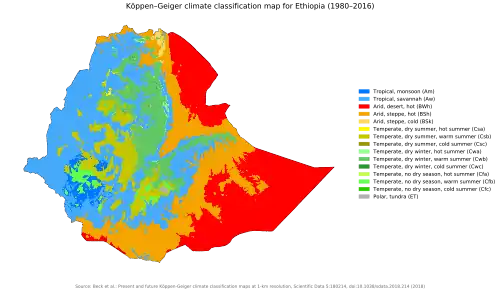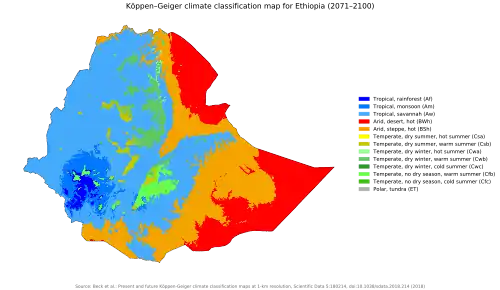Climate change in Ethiopia is affecting the people in Ethiopia due to increased floods, heat waves and infectious diseases.[1] In the Awash basin in central Ethiopia floods and droughts are common. Agriculture in the basin is mainly rainfed (without irrigation systems). This applies to around 98% of total cropland as of 2012. So changes in rainfall patterns due to climate change will reduce economic activities in the basin.[2] Rainfall shocks have a direct impact on agriculture. A rainfall decrease in the Awash basin could lead to a 5% decline in the basin's overall GDP. The agricultural GDP could even drop by as much as 10%.[2]
Impact on the natural environment
Temperature and weather changes
Between 1960 and 2006, the main annual temperature increased by 1.3°C. On average, the rate would be 0.28°C in temperature per decade.[3][4] A study from 2008 predicted further warming of 0.7°C and 2.3°C by 2020s and 1.4°C by 2050s.[5]


Rainfall, droughts and floods

Ethiopia has two main wet seasons per year. It rains in the spring and summer. These seasonal patterns of rainfall vary a lot across the country.[7][8] Western Ethiopia has a seasonal rainfall pattern that is similar to the Sahel. It has rainfall from February to November (which is decreasing to the north), and has peak rainfall from June to September. Southern Ethiopia has a rainfall pattern similar to the one in East Africa. There are two distinct wet seasons every year, February to May, and October to November.[9][8] Central and eastern Ethiopia has some rainfall between February and November, with a smaller peak in rainfall from March to May and a second higher peak from June to September.[8]


In 2022 Ethiopia had one of the most severe La Niña-induced droughts in the last forty years. It came about due to four consecutive rainy seasons which did not produce enough rain.[10] This drought increased water insecurity for more than 8 million pastoralists and agro-pastoralists in the Somali, Oromia, SNNP and South-West regions. About 7.2 million people needed food aid, and 4.4 million people needed help to access water. Food prices have increased a lot due to the drought conditions. Many people in the affected area have experienced food shortages due to the water insecurity situation.[10]
The exact attribution of climate change to the occurrence of droughts and floods in Ethiopia is difficult. One study from 2022 stated for Ethiopia: "While regional models predict increase in rainfall, higher resolution analyses for Ethiopia suggest spatial variations in which there are both increases and decreases in the overall rainfall averages. An increase in the rainfall variability is also predicted, with a rising frequency of both extreme flooding and droughts that could seriously affect agricultural production."[1]
Significant droughts lead to drying of water resources and eventually water scarcity. Subsequent outcomes include poor hygiene and can lead to faeco-oral transmission of disease.[1]
In 2016, deadly floods hit Ethiopia, leaving at least 200 people dead and over 200,000 people homeless as seasonal rains came early to the country.[11] Causes for floods can be deforestation, presence of rivers such as the Baro, Akobo, Gilo, and Alwero, in low lying homogeneous topography and climate change.[1]
Climate change affects many factors associated with droughts. These include how much rain falls and how fast the rain evaporates again. Warming over land increases the severity and frequency of droughts around much of the world.[13][12]: 1057 In some tropical and subtropical regions of the world, there will probably be less rain due to global warming. This will make them more prone to drought. Droughts are set to worsen in many regions of the world. These include Central America, the Amazon and south-western South America. They also include West and Southern Africa. The Mediterranean and south-western Australia are also some of these regions.[12]: 1157
Higher temperatures increase evaporation. This dries the soil and increases plant stress. Agriculture suffers as a result. This means even regions where overall rainfall is expected to remain relatively stable will experience these impacts.[12]: 1157 These regions include central and northern Europe. Without climate change mitigation, around one third of land areas are likely to experience moderate or more severe drought by 2100.[12]: 1157 Due to global warming droughts are more frequent and intense than in the past.[14]
Several impacts make their impacts worse. These are increased water demand, population growth and urban expansion in many areas.[15] Land restoration can help reduce the impact of droughts. One example of this is agroforestry.[16]Impact on people
Economic impacts
Climate change also affects the gross domestic product (GDP) of the country by reducing between 0.5% and 2.5% each year (estimate for 2010).[17]
In the Awash basin in central Ethiopia floods and droughts are common. Agriculture in the basin is mainly rainfed (without irrigation systems). This applies to around 98% of total cropland as of 2012. So changes in rainfall patterns due to climate change will reduce economic activities in the basin.[2] Rainfall shocks have a direct impact on agriculture. A rainfall decrease in the Awash basin could lead to a 5% decline in the basin's overall GDP. The agricultural GDP could even drop by as much as 10%.[2]
References
- 1 2 3 4 Simane, B.; Beyene, H.; Deressa, W.; Kumie, A.; Berhane, K.; Samet, J. (23 June 2022). "Review of Climate Change and Health in Ethiopia". The Ethiopian Journal of Health Development = Ya'ityopya Tena Lemat Mashet. 30 (1 Spec Iss): 28–41. PMC 5578710. PMID 28867919.
- 1 2 3 4 Borgomeo, Edoardo; Vadheim, Bryan; Woldeyes, Firew B.; Alamirew, Tena; Tamru, Seneshaw; Charles, Katrina J.; Kebede, Seifu; Walker, Oliver (2018). "The Distributional and Multi-Sectoral Impacts of Rainfall Shocks: Evidence From Computable General Equilibrium Modelling for the Awash Basin, Ethiopia". Ecological Economics. 146: 621–632. doi:10.1016/j.ecolecon.2017.11.038.
 Text was copied from this source, which is available under a Creative Commons Attribution 4.0 International License
Text was copied from this source, which is available under a Creative Commons Attribution 4.0 International License - ↑ Conway D, Schipper ELF. Adaptation to climate change in Africa: Challenges and opportunities identified from Ethiopia. Global Environmental Change. Vol. 21. 2011. pp. 227–37.
- ↑ Climate-Resilient Green Economy (CRGE); CRGE. Green economy strategy of Ethiopia, editor. Ethiopia's Climate-Resilient Green Economy Addis Ababa, Ethiopia. Federal Democratic Republic of Ethiopia (PDF). 2011. p. 188.
- ↑ World Bank. A Country Study on the Economic Impacts of Climate Change, Environment and Natural Resource Management, Sustainable Development Department, Africa Region, Development Prospects Group. 2008 Report No. 46946-ET (PDF).
- ↑ "CHIRPS: Rainfall Estimates from Rain Gauge and Satellite Observations | Climate Hazards Center - UC Santa Barbara". www.chc.ucsb.edu. Retrieved 2022-09-14.
- ↑ Taye, Meron Teferi; Dyer, Ellen; Charles, Katrina J.; Hirons, Linda C. (2021). "Potential predictability of the Ethiopian summer rains: Understanding local variations and their implications for water management decisions". Science of the Total Environment. 755 (Pt 1): 142604. Bibcode:2021ScTEn.755n2604T. doi:10.1016/j.scitotenv.2020.142604. PMID 33092844. S2CID 225052023.
- 1 2 3 Abebe, Dawit (2010). "Future climate of Ethiopia from PRECIS Regional Climate Model Experimental Design" (PDF). Met Office UK. Retrieved 21 August 2022.
- ↑ Dyer, Ellen; Washington, Richard; Teferi Taye, Meron (May 2020). "Evaluating the CMIP5 ensemble in Ethiopia: Creating a reduced ensemble for rainfall and temperature in Northwest Ethiopia and the Awash basin". International Journal of Climatology. 40 (6): 2964–2985. Bibcode:2020IJCli..40.2964D. doi:10.1002/joc.6377. S2CID 210622749.
- 1 2 "Ethiopia: Drought Update No. 4, June 2022 - Ethiopia | ReliefWeb". reliefweb.int. 3 June 2022. Retrieved 2022-07-06.
- ↑ "Ethiopia: 28 People Killed in Floods in Remote Regions". VOA. 5 April 2016. Retrieved 14 June 2016.
- 1 2 3 4 5 6 7 Douville, H., K. Raghavan, J. Renwick, R.P. Allan, P.A. Arias, M. Barlow, R. Cerezo-Mota, A. Cherchi, T.Y. Gan, J. Gergis, D. Jiang, A. Khan, W. Pokam Mba, D. Rosenfeld, J. Tierney, and O. Zolina, 2021: Chapter 8: Water Cycle Changes. In Climate Change 2021: The Physical Science Basis. Contribution of Working Group I to the Sixth Assessment Report of the Intergovernmental Panel on Climate Change [Masson-Delmotte, V., P. Zhai, A. Pirani, S.L. Connors, C. Péan, S. Berger, N. Caud, Y. Chen, L. Goldfarb, M.I. Gomis, M. Huang, K. Leitzell, E. Lonnoy, J.B.R. Matthews, T.K. Maycock, T. Waterfield, O. Yelekçi, R. Yu, and B. Zhou (eds.)]. Cambridge University Press, Cambridge, United Kingdom and New York, NY, US, pp. 1055–1210, doi:10.1017/9781009157896.010.
- ↑ Cook, Benjamin I.; Mankin, Justin S.; Anchukaitis, Kevin J. (2018-05-12). "Climate Change and Drought: From Past to Future". Current Climate Change Reports. 4 (2): 164–179. Bibcode:2018CCCR....4..164C. doi:10.1007/s40641-018-0093-2. ISSN 2198-6061. S2CID 53624756.
- ↑ "Scientists confirm global floods and droughts worsened by climate change". PBS NewsHour. 2023-03-13. Retrieved 2023-05-01.
- ↑ Mishra, A. K.; Singh, V. P. (2011). "Drought modeling – A review". Journal of Hydrology. 403 (1–2): 157–175. Bibcode:2011JHyd..403..157M. doi:10.1016/j.jhydrol.2011.03.049.
- ↑ Daniel Tsegai, Miriam Medel, Patrick Augenstein, Zhuojing Huang (2022) Drought in Numbers 2022 - restoration for readiness and resilience, United Nations Convention to Combat Desertification (UNCCD)
- ↑ Bank, World (January 2010). World Bank. License: CC BY 30 Unported. Washington DC: 2010. Economics of Adaptation to Climate Change, Ethiopia.